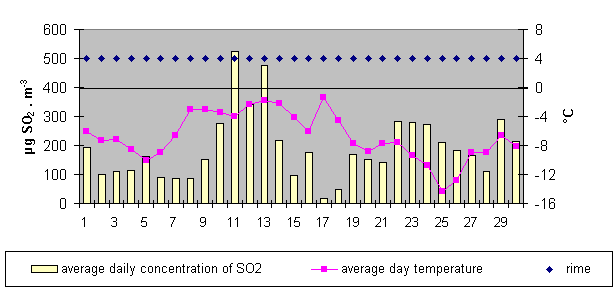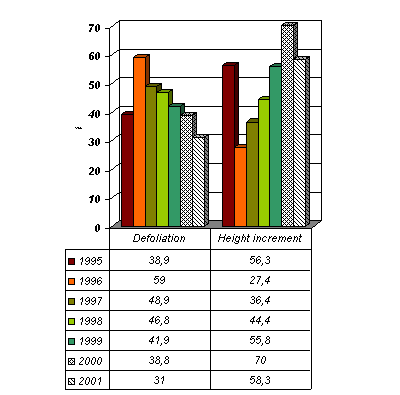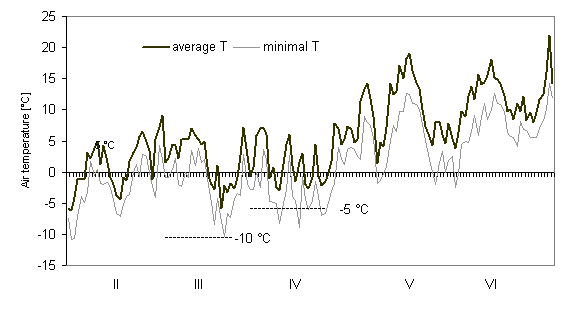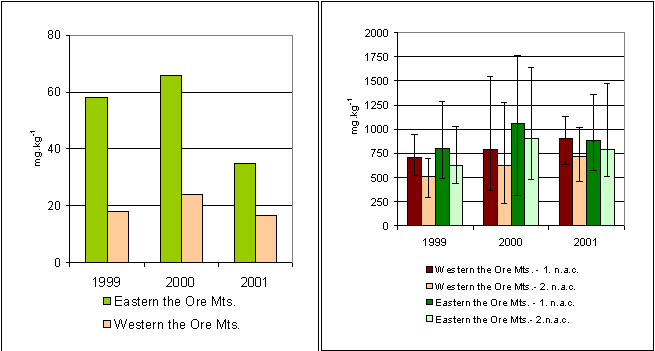

0793-B3
Bohumir Lomsky, Vit Sramek 1
Forests in the Czech Republic are highly influenced by the antropogenous factors - those are particularly air pollution, pollutant deposition, soil degradation, change of the natural forest ecosystems, and also global climate changes. Significant damages due to air pollution are visible already 50 years (the Ore Mts. region).
Since 1989 the sulfur emission has decreased significantly. By the end of 90ies SO2 emission was reduced in nearly 90 %. In the 1990 - 1995 period, the change of air pollution situation in mountain regions resulted into the spruce stands condition improvement, and good progress of transitory stands (birch, blue spruce, mountain pine, alder etc.). Following development was not that ideal, however. Since 1995, various symptoms of damage have been observed, caused by the complex of factors.
During the winter of 1995/96, within the whole region of the Czech Republic, reddening of the last needle year class of spruce was observed in the altitude over 700 m. These symptoms were the most visible in the eastern part of the Ore Mts., where 3-4 needle year classes were affected, or even tree decay observed. An acute damage was caused by direct impact of the high SO2 concentrations. The average defoliation was over 60 % in stands assessed. About 12,578 ha of spruce stands were damaged, 1,300 ha of them has completely died. The rest have regenerated successfully in following period.
After following winter, in spring 1997, the damage to transitory birch stands was observed in all the northern mountain regions. In the Ore Mts. ridge birch did not flush at all, the leaf lost was observed in a vast area with variable intensity in altitudes over 800 m above sea level during the springtime. In total 3,400 ha of birch stands was damaged, in 1998 it was nearly 5,428 ha. Birch completely died at about 2,550 ha, in following period the damage development stagnated. Similar damage of smaller extent has been observed also in other parts of the country, in higher elevations, situated above the inversion layer during the spring months.
After winter 1999, vast damage of the spruce stands, manifested in yellowing of older needle year classes, and gradual needle drying and fall, affecting the stand of all age categories, was observed in the western part of the Ore Mts. but also in other regions. Yellowing was observed on 2,000 ha in 1999, next year it was 6,500 ha, and in 2001 about 9,000 ha was damaged within the Ore Mts.
A new type of damage has been observed in the Orlicke Mts. ridge caused again by the stressing factors complex after the winter 2001/02. Nitrogen deposition seems to be one of major problem. The damage presented shows that in spite of significant lowering of air pollution load the forest stands health state in air polluted regions is not stabilized.
Forests in the Czech Republic (here-in-after CR) are highly influenced by antropogenous factors. Among them it is mainly air pollution (SO2, NOx etc.), pollutant deposition (S, N), soil degradation, change of the natural forest ecosystems during the history, and also global climate changes. Significant forest damage due to air pollution has been visible for more than 50 years ago. Vast damage has been observed mainly after an extreme temperature break in December 1978. Similar damage has been observed in all the ridge parts in Northern Bohemia (Materna, 1984). In the middle 90ies, about 60 % of the forest stands in CR were damaged. Emission of SO2, the main pollutant affecting the forest stands, culminated in the eighties, when more than 2 mil. ton was produced per year. At the beginning of 90ies the air pollution situation in CR started to change rapidly. Sulfur emission has decreased significantly thanks to the reduction of industrial production (heavy and chemical industry) and use of de-sulfur devices at the main pollution sources (brown-coal power plants). By the end of 90ies the emission of SO2 was reduced in nearly 90 %. Between 1990-1995, the change in the air pollution situation in mountain regions resulted in the improvement of the health state of spruce stands, and good development of the transitory stands (birch, blue spruce, mountain pine, alder etc.) which were planted mostly in 80ies in the ridge area (especially in the Ore Mts.). Since 1995, various symptoms of damage have been observed, caused by the complex of antropogenous and meteorological factors in different mountain regions of the Czech Republic.
The attempt to cope with the problem of forest health status is based on the transects of the research plots, established since the beginning of nineties in the young spruce stands and transitory stands, in regions of former vast clear cuts. Within the Ore Mts. it is 20 plots in the spruce stands and 12 plots in the transitory birch stands. In the Jizerske Mts. it is 18 plots and 10 plots in the Orlicke Mts. in the young spruce stands. Next follow-up information on the visible symptoms was obtained from the temporary mainly spruce plots established during the survey.
In the spruce stands defoliation, number of the needle year classes, and the height increment are assessed every year. Based on the ICP- Forests methodology, also the content of air pollutants and nutrients in the assimilation organs are classified yearly, and the nutrient supply, in the humus layer and mineral soil, are analyzed in a five-year interval (Manual of ICP-Forests). In the transitory birch stands the health state is assessed every year. In 1999, the quality and number of roots was also evaluated, and the chemical analysis of the assimilation organs, humus and mineral soil was done. To understand the impact of other stressing factors, also meteorological data and measuring of the air pollution characteristics was used.
During the winter of 1995/96, in altitudes over 700 m within the whole region of the Czech Republic, reddening of the last needle year class of spruce was observed.
These symptoms were the most visible in the eastern part of the Ore Mts., where 3-4 needle year classes were affected, or even tree decay observed. The symptoms of the damage were the same as in the 40ies and 70ies of the last century. An acute damage was caused by the direct impact of the high SO2 concentration in the air. The stand damage was connected with a long-lasting inversion situation, going up to 700 m, sharp temperature decrease, hard frost and following forming of the frost deposit. Long-term south-eastern flow lead to pollution cumulating in the ridge part of the Ore Mts., thus the extreme values have been reached even under the condition of comparatively low emission. From November till January the average daily concentrations of SO2 were many times over 500 µg.m-3 (Vancura 1999), and the 30 min. concentrations have reached even 3000 µg.m-3 (see Fig. 1.).
Fig. 1: The impact of stress factors; Medenec - January 1996

High air pollution load in this part of the Ore Mts. was proved by a high concentration of the stress elements (S, F) in the needle samples. The sulfur content in the first needle year class was 2,755 mg.kg-1 and the fluorine content was 19.03 mg.kg-1 within the most affected regions. Mostly the whole tree crown, or the upper part respective was affected. The average defoliation was over 60 % in the stands assessed. In some stands only 10 % of vital bud proved that the vitality was decreasing with tree age (Lomsky & Srámek 1999). About 12,578 ha of the spruce stands were damaged, 1,300 ha of forests has completely died (Report MA 1997). In the following period the spruce stands have regenerated successfully (see Fig. 2).
After the following winter, in spring 1997, the damage to the transitory birch stands was observed in all the northern mountain regions. In some stands of the Ore Mts. birch did not flush at all, during April and May the leaf loss was observed in a vast area (see Photo 2). The damage was observed in altitudes over 800 m above sea level, the intensity was variable. Warm temperatures at the end of winter (see Fig. 3), followed with sharp frost breaks, were an important factor, causing the damage to the root system when the snow melted. The damage also shows the level of long-term pollution load, soil degradation and genetic qualities of the transitory stands.
In 1997, in total 3,400 ha of the birch stands was damaged, in 1998 it was nearly 5,428 ha. Birch completely died at about 2,550 ha (Report MA 2000). In the following period the damage development stagnated.
After winter 1999, vast damage of the spruce stands, manifested in yellowing of older needle year classes, and gradual needle drying and fall, affecting the stand of all age categories, was observed.
Fig. 2: Comparison of mean defoliation and height increment of damaged young spruce stands in 1995 - 2001

Fig. 3: The course of temperature during winter and spring 1997

Similar damage of smaller extent has been observed also in the other parts of the Czech Republic, in higher elevations, situated over the inversion layer during the spring months.
The same symptoms were also observed in some localities in the Jizerske and Orlicke Mts. Color changes characterize so called "new type of forest damage", as described in the 80ies in Western Europe (Huettl 1998, Kaupenjohann et al 1988). They are caused by the long-term effect of comparatively low air pollution concentration and acid deposition on the pure, degrading forest soils. The upper soil layer is acidified, and the basic nutrients, mainly Mg and Ca, eluded from the sorption complex. Significant Mg deficiency in the soil affects the nutrition supply of the spruce stands (Fig. 4). The investigation has proved critical deficiency of the basic nutrients, mainly calcium and magnesium. Their content in the needles was at physiological minimum level (300 mg.kg-1) (Fig. 5). In 1999 yellowing was observed in 2000 ha, in following year it was 6,500 ha, and in 2001 about 9000 ha was damaged within the Ore Mts., in the Jizerske Mts. it was about 1000 ha. Since 2000 liming and fertilizing has been applied in the damaged stands.
Fig. 4: Comparison of available magnesium Fig.5: Comparison of Mg content in spruce content in soil (mg/kg) needles (mg/kg)

After winter 2001/02 in the ridge part of the Orlicke Mts., over 750 m, a new type of damage has been observed, caused by complex stressing factors (see Photo 4). Nitrogen deposition, oscillating in the range of 30 to 60 kg.ha-1 in the 90ties, was of importance. An increased nitrogen input in higher elevations most probably influences positively the high increment of spruce (1m), and makes maturing of the springs slower. The stands start to be sensitive to damage caused by frost, which is proved by the higher N:K ratio in needles of damaged individuals (see Fig. 6).
Fig. 6: Nitrogen content in the 1st needle age class.

This fact, together with other stressors, such as an inversion, sharp temperature changes, hard frost, and winter transpiration, resulted in significant damage of the upper part of Norway spruce. Damage of a different level was observed at the area of about 980 ha in 2002.
During the last decade in the mountain regions: i) change in the pollution spectrum occurred, the importance of once less significant pollutants increased (NOx, O3), ii) significant negative long-term impact of high sulfur deposition is observed, mainly in degrading forest soils; iii) the impact of sharp changes of meteorological factors - temperature, precipitation - start to be more important; iv) acid deposition is a permanent risk which will affect the tree growth in the ridge parts; v) every forest region is specific, to find support for the long-term intensive research of the forest ecosystems in mountain regions is of importance.
Hüttl, R. 1998: Neuartige Waldschäden. Berlin-Brandenburgische Akademie der Wissenschaften, Berichte und Abhandlungen, Band 5, 215 pp.
Kaupenjohann, M., Schneider, B., Hantschel, R., Zech, W., Horn R. 1988: Sulphur acid rain treatment of Picea abies (L.) Karst. effects on nutrient solution, throughfall chemistry, and tree nutrition. Z. Pflanzenernähr. Bodenk. 151: 123-126.
Lomsky, B., Srámek,V. 1999: damage of the forest stands in the Ore Mts. during period 1995-1997. J. For. Sci. 45: 169-180.
Materna, J. 1984: Ohrozeni horskych smrcin znecistenim ovzdusi. Lesnictvi 30: 559-568.
Report on the state of forest and forestry in the Czech Republic 1997 and 2000: Ministry of Agriculture of the Czech Republic, pp. 124 resp. pp. 137.
Vancura, K. 1999: Impact in Central and Eastern Europe; In: Innes & Oleksyn: Impact and Amelioration of Heavily Polluted Regions; IUFRO Report 1, 1999, ISBN 085-1993764, p. 174.
1 Forestry and Game Management Research Institute, 156 04 Praha 5, Zbraslav, Czech Republic
E-mail: [email protected]; [email protected]